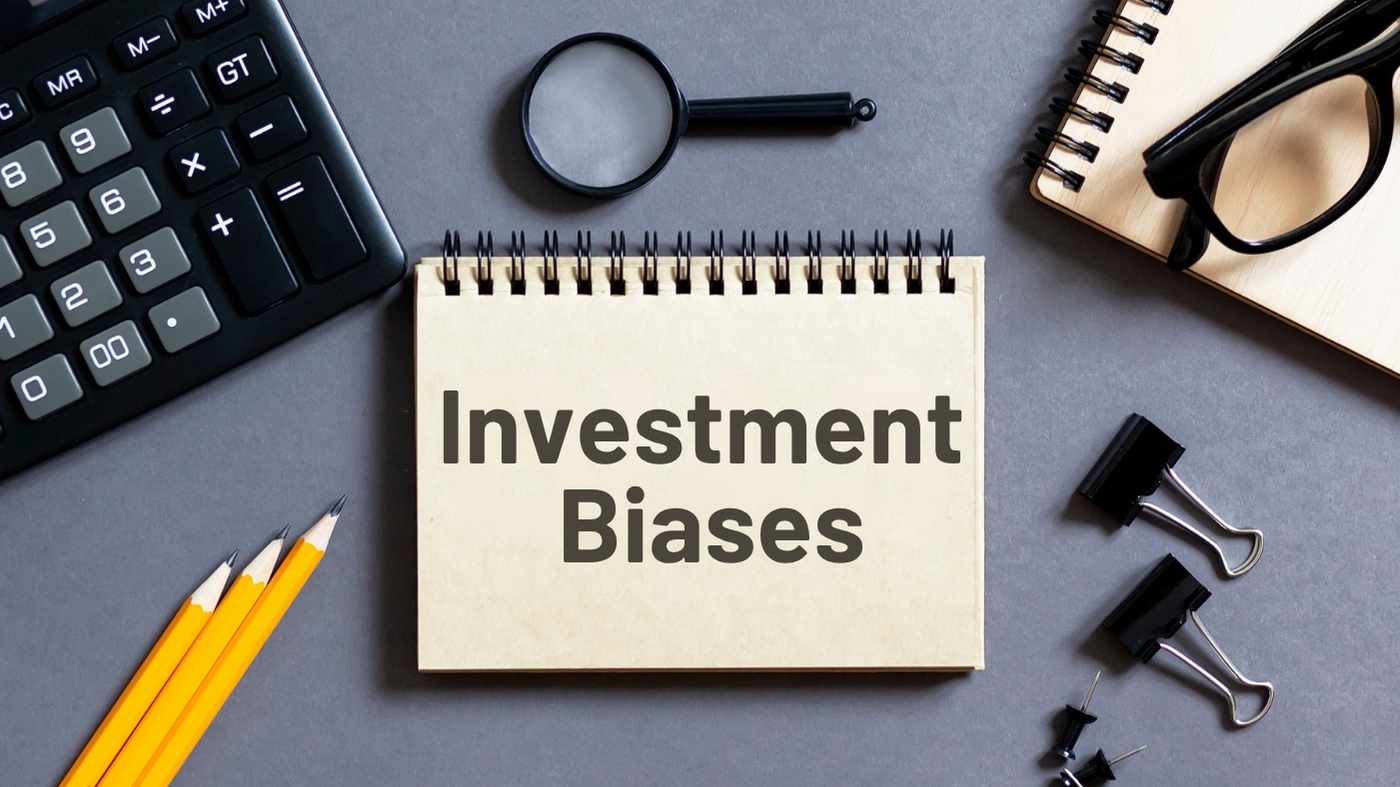Investing is far more than just examining numbers, charts, or returns; it’s a complex and emotionally charged journey. Every investor, regardless of their level of experience, brings their own distinct beliefs, habits, and reactions that shape their financial decisions. These are known as biases.
Investment biases are often hidden, automatic mental shortcuts that can distort our judgment and cause us to make less-than-optimal financial choices. You might feel overconfident after a few good stock picks, or sell everything in panic when markets crash. You might copy what your friends are doing or stick to a bad investment simply because you’re emotionally attached.
The truth is, you can’t eliminate biases—but you can learn to manage them. This blog will help you understand what these biases are, how they work, and most importantly, how you can train yourself to outsmart them and build a healthier, more disciplined approach to investing.
What is Investment Bias?
Investment bias refers to a systematic deviation from rational judgment, leading to decisions that are more influenced by emotion or flawed logic than by sound analysis and reasoning. These biases skew your perception of risk, value, and opportunity.
Let’s break that down:
- Imagine selling a stock just because its price dropped today.
- Or chasing a hot mutual fund just because everyone else is investing in it.
- Or refusing to sell a bad investment because you can’t bear the loss.
These actions are not rational—they are biased.
Investment bias doesn’t mean you’re unintelligent. It means you’re human. But the best investors recognise when their minds are playing tricks, and they act consciously to correct course.
What is Behavioural Bias in Investing?
Emotions and psychological triggers drive behavioural biases. They stem from our instinctive reactions to fear, greed, excitement, regret, or anxiety.
In investing, behavioural biases often:
- Encourage short-term thinking
- Drive herd behaviour (doing what others are doing)
- Causes panic selling or euphoric buying.
For example:
- Feeling fearful during a market crash, you sell at a loss.
- Seeing everyone rush into a hot IPO, you invest without checking fundamentals.
Behavioural finance—the field that studies these patterns—shows that people are far from rational. Understanding behavioural bias enables you to recognise your emotional pitfalls and respond with logic, rather than panic.
What is Cognitive Bias?
Cognitive bias is rooted in faulty mental processing. Unlike behavioural bias, which is emotional, cognitive bias is about how we misinterpret data and reality.
Cognitive biases often:
- Lead to overconfidence in your ability
- Causes selective memory or focus.
- Distort facts to fit your beliefs.
Examples include:
- Confirmation bias: You read only articles that support your investment.
- Anchoring: You fixate on a stock’s original price and refuse to sell.
- Recency bias: You give undue weight to recent market events.
These thinking errors can trick even seasoned investors. Recognising cognitive bias enables you to apply a more scientific and objective lens to your financial decisions.
Common Investment Biases
Let’s explore the most frequent biases investors face:
- Loss Aversion
We feel the pain of a loss more strongly than the pleasure of an equivalent gain. As a result, investors:
- Avoid investments perceived as risky, even if they offer better returns.
- Hold losing investments in the hope they will bounce back.
- Avoid investments perceived as risky, even if they offer better returns.
- Herd Mentality
People tend to mimic the behaviour of the crowd. When everyone is buying a stock or a fund, you might too, ignoring your strategy. - Anchoring Bias
You base decisions on a single number or reference point—like the purchase price of a stock—even if that number is now irrelevant. - Confirmation Bias
You selectively seek information that confirms your beliefs and ignore data that contradicts them. This limits learning and objectivity. - Overconfidence Bias
You believe your analysis is superior or that you can consistently beat the market. Overconfidence often leads to excessive risk-taking. - Recency Bias
You assume that what happened recently will continue to happen. For example, investing in a fund just because it performed well last month. - Disposition Effect
You sell winners early to book profits and hold losers too long to avoid admitting a mistake. This reduces overall portfolio efficiency.
How to Recognise Your Own Biases
The first step to beating bias is self-awareness. You can’t fix what you can’t see. Here’s how to identify your biases:
- Keep an investment diary: Record the reasons why you bought or sold an asset. Review this periodically to identify patterns.
- Notice emotional cues: Are you feeling anxious, greedy, or rushed when making investment decisions?
- Review your past performance: Which investments went wrong and why? Was there a recurring mistake?
- Ask reflective questions: “Am I doing this because of logic, or fear?”
- Consult a neutral third party, such as an advisor or mentor, who can provide unbiased insight into your thinking.
Recognising a bias doesn’t make you weak—it makes you wiser.
The Challenge of Overcoming Biases
Even when you recognise a bias, overcoming it can be a challenging task. That’s because biases are deeply ingrained in your thinking and behaviour. They’re built from:
- Childhood money habits
- Cultural influences
- Social media trends
- Emotional experiences with money
Additionally, the brain is naturally inclined to be lazy—it prefers shortcuts and habits over thorough analysis. Overcoming bias means actively slowing down and thinking clearly, which requires effort and discipline.
It also requires humility—to admit, “I could be wrong.”
Investors who develop this kind of emotional intelligence are better equipped to navigate market cycles and achieve long-term wealth creation.
Strategies to Mitigate Biases
Here are tried-and-tested ways to reduce the impact of bias on your investments:
- Create an Investment Policy Statement (IPS)
Clearly define your financial goals, risk tolerance, and strategy. This acts like a compass during volatile markets. - Use SIPs and STPs
Automating your investments reduces the need for emotional decisions and ensures consistent investing. - Diversify
Spread your money across asset classes and sectors. This protects you from being overly optimistic or overly pessimistic about a single idea. - Schedule Rebalancing
Regularly realign your portfolio to original targets. It disciplines you to sell high and buy low. - Ignore Market Noise
Turn off news alerts, reduce social media scrolling, and avoid reacting to hype. - Work with a Professional
A financial advisor can challenge your assumptions and keep you accountable. - Set Long-Term Horizons
View investments in terms of 5–10 years. This mindset removes pressure to act on every short-term fluctuation.
Noise in Financial Analysis
“Noise” is information that feels urgent or important, but isn’t. In investing, noise can be dangerous.
Examples of noise:
- Daily stock tips on YouTube
- Headlines like “Sensex crashes 500 points!”
- Peer pressure to chase trending funds
The danger is that noise feeds your biases:
- Recency bias: When markets fall today, you assume they’ll fall tomorrow.
- Herd mentality: You follow the crowd, not your strategy.
To reduce noise:
- Set limits on how often you check your portfolio
- Read financial content from credible, data-backed sources.
- Stick to your plan—review it quarterly, not daily.
Final Words
Biases are not flaws—they are features of the human mind. But left unchecked, they can sabotage your financial journey.
Being a successful investor is not about predicting the market—it’s about mastering your psychology.
Start with awareness. Add structure. Build discipline.
The most powerful tool in your portfolio isn’t your best-performing stock or fund. You can stay rational when others are emotional.
Outsmarting your biases isn’t a one-time act—it’s a lifelong practice.
📘 Further Reading: Outsmarting Investment Biases
🔹 1. The Behavioral Biases of Individuals – CFA Institute
A comprehensive guide categorising cognitive vs emotional biases and steps investors can take to recognise and mitigate their errors.
🔹 2. Outsmart Your Own Biases – Harvard Business Review
Practical and research-backed strategies to broaden thinking and counteract common cognitive biases in investing.
🔹 3. 5 Behavioral Biases That Can Impact Your Investing Decisions – William & Mary
A concise and practical breakdown of biases, including overconfidence, loss aversion, and herd behaviour, along with tips to combat them.
🔹 4. Behavioral Finance: Biases, Emotions and Financial Behavior – Investopedia
A foundational article outlining significant biases and how they disrupt rational financial decisions and market efficiency.
🔹 5. 5 Behavioral Biases To Avoid While Investing – The Economic Times
A quick and relevant guide for Indian investors on common pitfalls like confirmation bias, herd behaviour, and overconfidence.
Disclaimer: The information provided in this blog is for educational and informational purposes only and should not be considered as financial, investment, or tax advice. While every effort has been made to ensure accuracy, readers must consult a qualified financial advisor before making investment decisions. VSJ FinMart is an AMFI-registered mutual fund distributor (MFD) that does not provide investment advisory services. Mutual fund investments are subject to market risks; please read all scheme-related documents carefully before investing.

